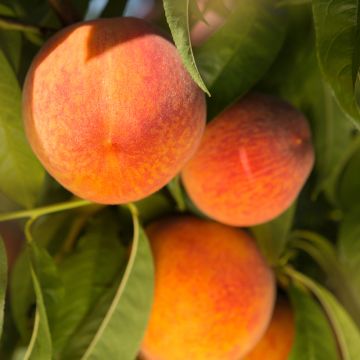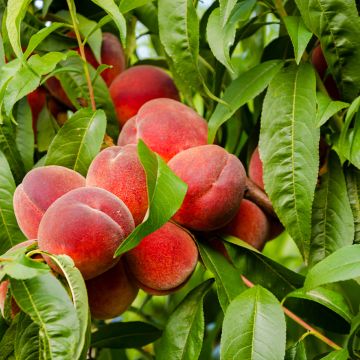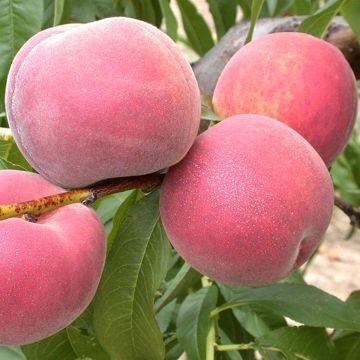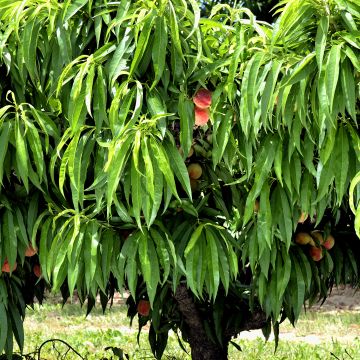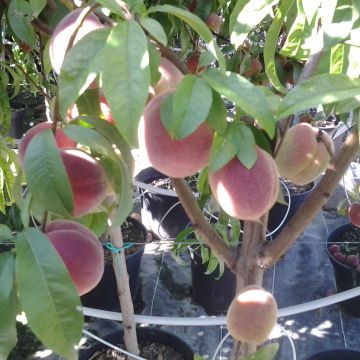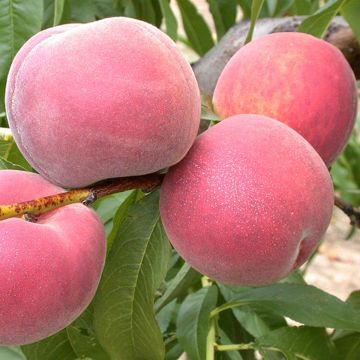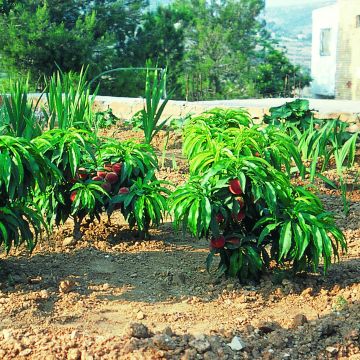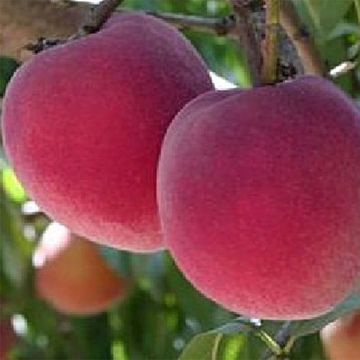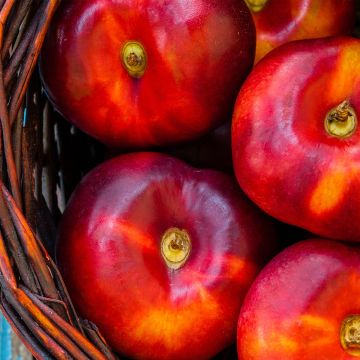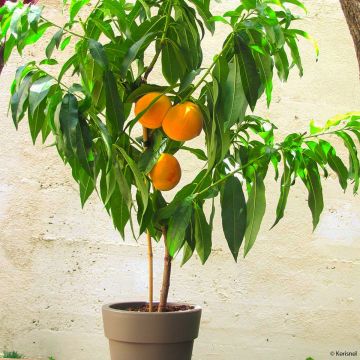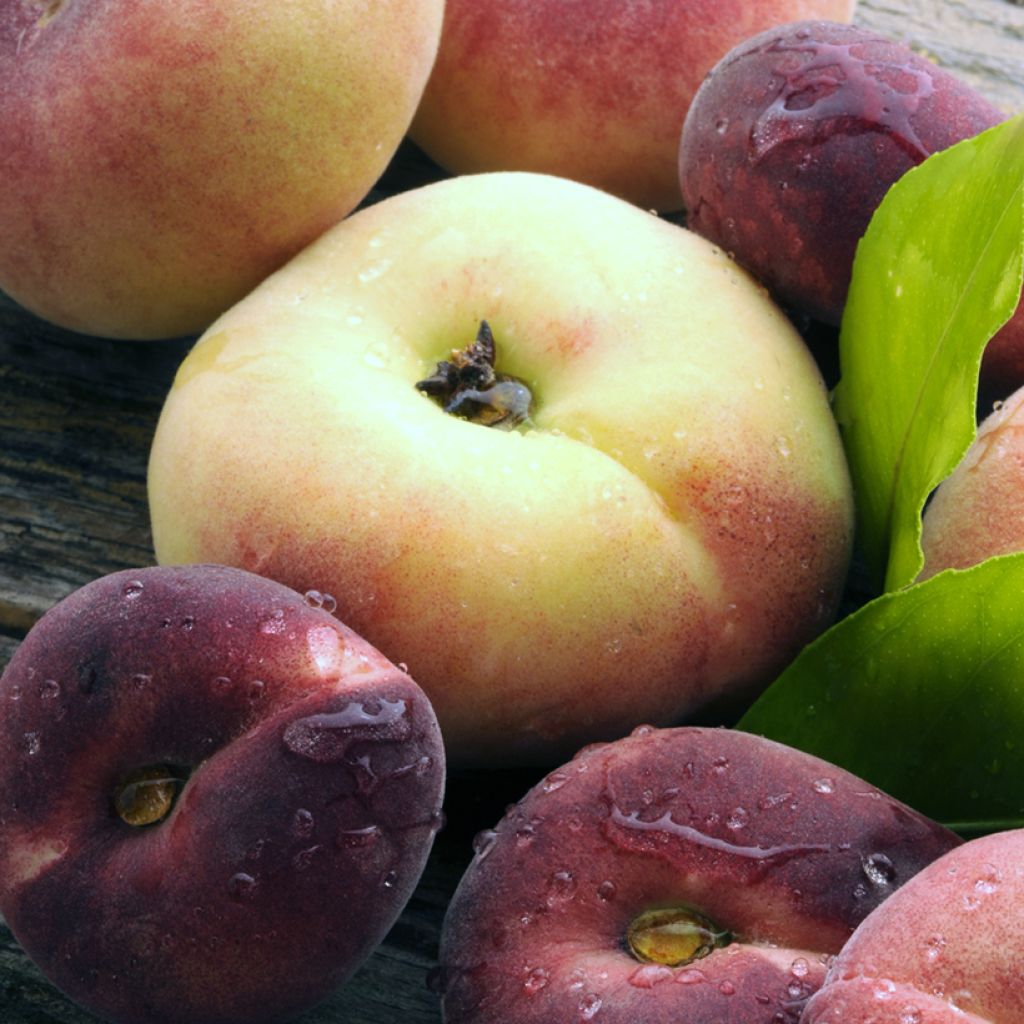

Prunus persica Platicarpa bianca - Flat Peach tree
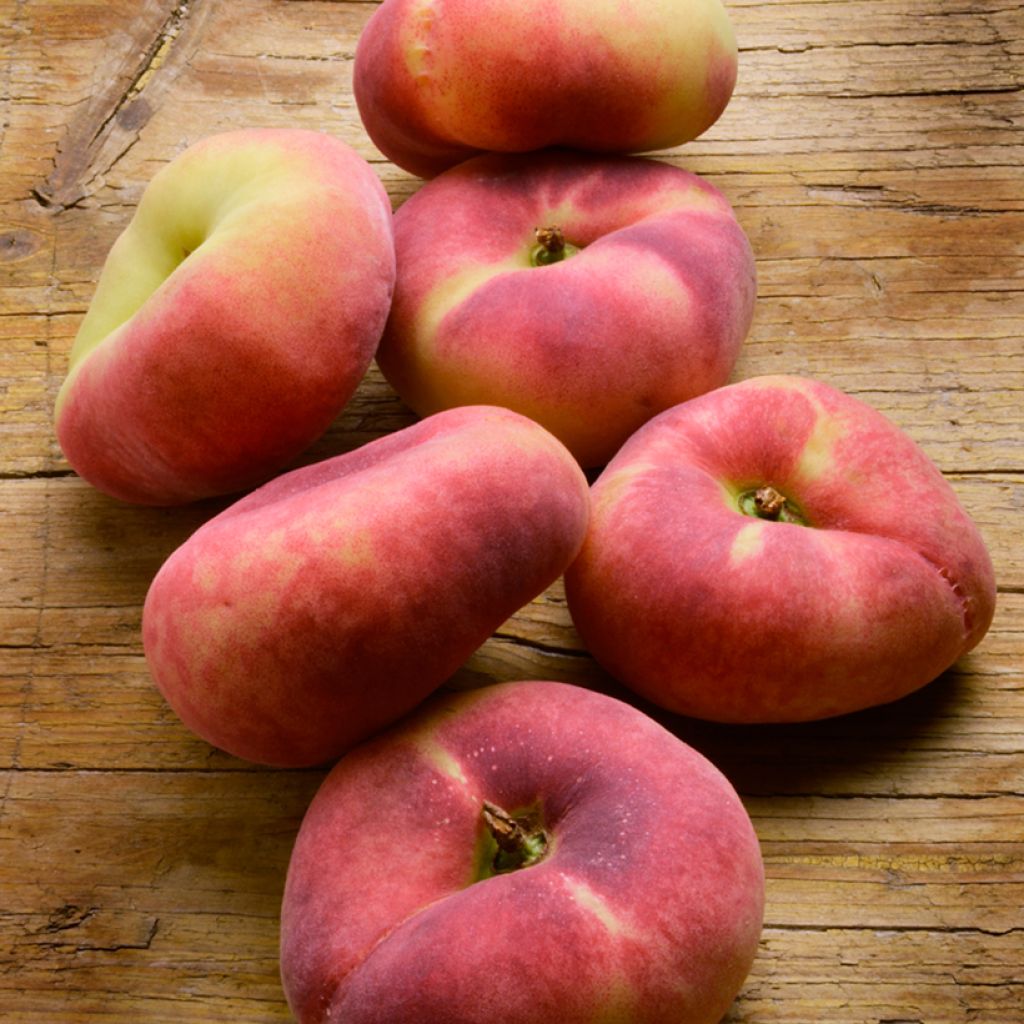

Prunus persica Platicarpa bianca - Flat Peach tree
Prunus persica Platicarpa bianca - Flat Peach tree
Prunus persica Platicarpa bianca
Flat Peach, Saturn
Beautiful plant, well-developed head received very well protected. Late flowering is a plus and moderate growth so it doesn't take up too much space. Perfect.
Kellordas, 21/12/2024
This item cannot be shipped to the selected country
Oversize package delivery charge from €6.90
Delivery to Corse prohibited
More information
Schedule delivery date,
and select date in basket
This plant carries a 6 months recovery warranty
More information
We guarantee the quality of our plants for a full growing cycle, and will replace at our expense any plant that fails to recover under normal climatic and planting conditions.
Oversize package: home delivery by special carrier from €6.90 per order..
Express home delivery from €8.90.
Delivery to Corse prohibited: UE law prohibits the import of this plant from mainland France to Corse as part of the fight against Xylella fastidiosa. Please accept our sincere apologies.
More information
Description
The Peach Tree Platicarpa bianca is a variety of Prunus persica with flat peaches, moderately vigorous and very productive. The spreading bushy tree produces flat peaches of pale yellow colour with pink hues when ripe, with thin and fuzzy skin. The large fruits offer white, tender, very sweet, soft and juicy flesh, with a highly aromatic and fragrant flavour. This fairly hardy variety can be grown in most regions, although the south remains its preferred area. However, its semi-late flowering makes it less susceptible to late spring frosts than others.
The Prunus genus, which includes fruit trees and ornamental plants, trees and bushes, is part of the extensive Rosaceae family. It is home to the majority of other fruit trees (Apple, Cherry, Apricot...), wild plants from the countryside and forests, and numerous ornamental plants (Kerria, Photinia, Amelanchier, Roses...). The name of the Prunus persica species comes from the Greeks who, during Alexander's expedition (4th century BC), discovered it in Persia and named it Persian apple, malum persicum. At that time, they were unaware that this small tree, although long cultivated in Persia, was actually native to Northern China and Mongolia.
Platicarpa bianca forms a small tree with a spreading habit, reaching 3 to 4 m in height, with a spread of 3.5 to 4 m. Its growth is moderately vigorous, with the plant budding relatively early in the season. However, flowering is semi-late, occurring towards the end of March and April, which exposes the flowers less to the risks of spring frost. The variety is self-fertile, eliminating the need to plant another tree for pollination. It also demonstrates significant floribundity, giving it a some ornamental interest when the small light pink flowers bloom. The fruit size is generally 120 to 160 grams, with a diameter of 6 to 8 cm. Ripening from mid-July in southern regions, and in August further north, the peaches are flat with a thick skin that turns from yellow to pink when ripe. The medium-sized stone is free, making fruit consumption easier. The white flesh is tender, with a fine and juicy texture. Fragrant and sweet, it is sweeter than round fruits. Peaches can be enjoyed raw, cooked, sweet, savoury, flambéed, frozen, or poached. They pair well with wine and certain meats, such as duck. They are found in numerous recipes, including jams, compotes, and pastries.
The very generous production of the Peach Tree Platicarpa bianca typically starts 2 to 3 years after planting. It is moderately resistant to common diseases, but it is a good idea to look out for peach leaf curl and apply preventive treatments if necessary.
Highly productive and easy to grow, the Platicarpa bianca peach tree can be the starting point of a small orchard where you can combine it with other unique fruit trees, such as the Stark Gold Sweet Cherry Tree. This self-fertile tree produces golden cherries that bring a surprising ornamental touch. To maintain both an ornamental and edible theme, the Korea Persimmon Tree stands out as an obvious choice. Not only does this Persimmon offer delicious late-season fruits from October, but they are particularly decorative and visible when the tree has shed its leaves. And before they fall, the leaves provide a spectacular display of flamboyant colours.
Report an error about the product description
Prunus persica Platicarpa bianca - Flat Peach tree in pictures


Plant habit
Fruit
Flowering
Foliage
Botanical data
Prunus
persica
Platicarpa bianca
Rosaceae
Flat Peach, Saturn
Cultivar or hybrid
Other Peach and Nectarine trees
Planting and care
The Platicarpa Bianca peach tree is preferably planted from October to December. Dig a hole two to three weeks before planting, twice as wide and deep as the pot. On planting day, place the tree with its pot in a tub of water, to moisten the entire root ball by capillarity. Place compost at the bottom of the hole. Place the tree in the hole, fill with soil mixed with compost. Gently firm around the base of the fruit tree as you fill, ensuring the roots are in close contact with the soil. The root ball should be completely covered, then water generously. Not very demanding in terms of soil type, it prefers light and permeable soils. Choose a sunny location as this variety doesn't like shade. Feed with an organo-mineral fertiliser richer in potash than in nitrogen from May onwards, in small and divided quantities to avoid sudden changes.
Planting period
Intended location
Care
-
, onOrder confirmed
Reply from on Promesse de fleurs
Haven't found what you were looking for?
Hardiness is the lowest winter temperature a plant can endure without suffering serious damage or even dying. However, hardiness is affected by location (a sheltered area, such as a patio), protection (winter cover) and soil type (hardiness is improved by well-drained soil).

Photo Sharing Terms & Conditions
In order to encourage gardeners to interact and share their experiences, Promesse de fleurs offers various media enabling content to be uploaded onto its Site - in particular via the ‘Photo sharing’ module.
The User agrees to refrain from:
- Posting any content that is illegal, prejudicial, insulting, racist, inciteful to hatred, revisionist, contrary to public decency, that infringes on privacy or on the privacy rights of third parties, in particular the publicity rights of persons and goods, intellectual property rights, or the right to privacy.
- Submitting content on behalf of a third party;
- Impersonate the identity of a third party and/or publish any personal information about a third party;
In general, the User undertakes to refrain from any unethical behaviour.
All Content (in particular text, comments, files, images, photos, videos, creative works, etc.), which may be subject to property or intellectual property rights, image or other private rights, shall remain the property of the User, subject to the limited rights granted by the terms of the licence granted by Promesse de fleurs as stated below. Users are at liberty to publish or not to publish such Content on the Site, notably via the ‘Photo Sharing’ facility, and accept that this Content shall be made public and freely accessible, notably on the Internet.
Users further acknowledge, undertake to have ,and guarantee that they hold all necessary rights and permissions to publish such material on the Site, in particular with regard to the legislation in force pertaining to any privacy, property, intellectual property, image, or contractual rights, or rights of any other nature. By publishing such Content on the Site, Users acknowledge accepting full liability as publishers of the Content within the meaning of the law, and grant Promesse de fleurs, free of charge, an inclusive, worldwide licence for the said Content for the entire duration of its publication, including all reproduction, representation, up/downloading, displaying, performing, transmission, and storage rights.
Users also grant permission for their name to be linked to the Content and accept that this link may not always be made available.
By engaging in posting material, Users consent to their Content becoming automatically accessible on the Internet, in particular on other sites and/or blogs and/or web pages of the Promesse de fleurs site, including in particular social pages and the Promesse de fleurs catalogue.
Users may secure the removal of entrusted content free of charge by issuing a simple request via our contact form.
The flowering period indicated on our website applies to countries and regions located in USDA zone 8 (France, the United Kingdom, Ireland, the Netherlands, etc.)
It will vary according to where you live:
- In zones 9 to 10 (Italy, Spain, Greece, etc.), flowering will occur about 2 to 4 weeks earlier.
- In zones 6 to 7 (Germany, Poland, Slovenia, and lower mountainous regions), flowering will be delayed by 2 to 3 weeks.
- In zone 5 (Central Europe, Scandinavia), blooming will be delayed by 3 to 5 weeks.
In temperate climates, pruning of spring-flowering shrubs (forsythia, spireas, etc.) should be done just after flowering.
Pruning of summer-flowering shrubs (Indian Lilac, Perovskia, etc.) can be done in winter or spring.
In cold regions as well as with frost-sensitive plants, avoid pruning too early when severe frosts may still occur.
The planting period indicated on our website applies to countries and regions located in USDA zone 8 (France, United Kingdom, Ireland, Netherlands).
It will vary according to where you live:
- In Mediterranean zones (Marseille, Madrid, Milan, etc.), autumn and winter are the best planting periods.
- In continental zones (Strasbourg, Munich, Vienna, etc.), delay planting by 2 to 3 weeks in spring and bring it forward by 2 to 4 weeks in autumn.
- In mountainous regions (the Alps, Pyrenees, Carpathians, etc.), it is best to plant in late spring (May-June) or late summer (August-September).
The harvesting period indicated on our website applies to countries and regions in USDA zone 8 (France, England, Ireland, the Netherlands).
In colder areas (Scandinavia, Poland, Austria...) fruit and vegetable harvests are likely to be delayed by 3-4 weeks.
In warmer areas (Italy, Spain, Greece, etc.), harvesting will probably take place earlier, depending on weather conditions.
The sowing periods indicated on our website apply to countries and regions within USDA Zone 8 (France, UK, Ireland, Netherlands).
In colder areas (Scandinavia, Poland, Austria...), delay any outdoor sowing by 3-4 weeks, or sow under glass.
In warmer climes (Italy, Spain, Greece, etc.), bring outdoor sowing forward by a few weeks.

































